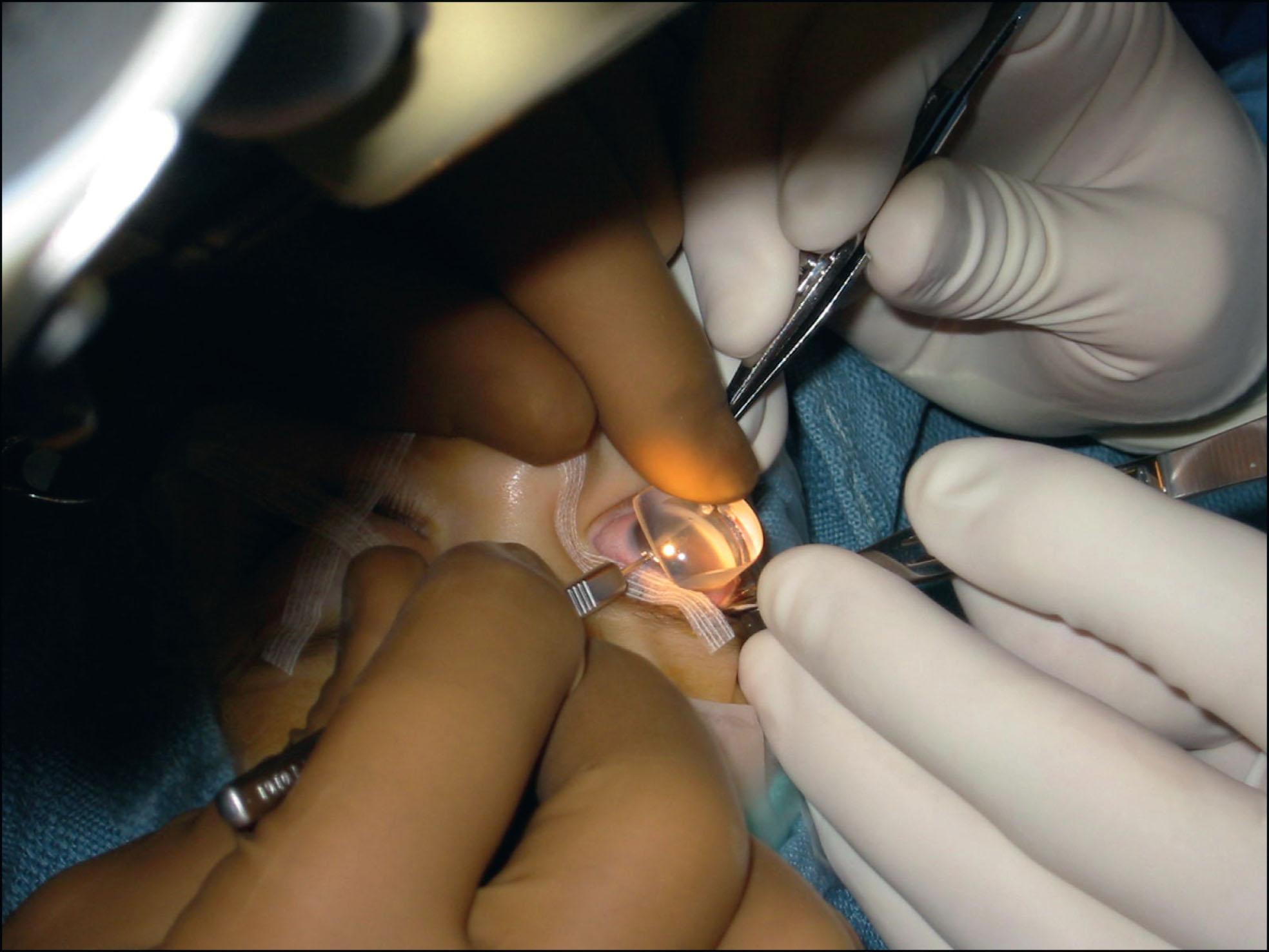Physical Address
304 North Cardinal St.
Dorchester Center, MA 02124
Anterior segment surgical techniques for the treatment of childhood glaucoma.
Angle surgery uses an ab interno or ab externo surgical approach to create a direct communication between the anterior chamber and Schlemm’s canal by incising the trabecular meshwork to lower intraocular pressure.
Trabeculotomy is performed when the cornea is too cloudy to allow visualization of the angle or when the operating surgeon is unfamiliar with the goniotomy technique.
Specialized operating instruments: goniotomy uses operating gonioscopy lens and cutting needle or knife; trabeculotomy uses trabeculotomes, Prolene suture, or illuminated microcatheter.
Success of goniosurgery for primary congenital glaucoma relies on adequate development of the filtration angles based on gonioscopic assessment.
Postoperative hyphema is a complication for both procedures.
Goniosurgery represents a unique approach to glaucoma surgery because its goal is to improve outflow facility. By incising the tissue obstructing the trabecular meshwork ( Fig. 10.25.1 ), a direct conduit between the anterior chamber and Schlemm’s canal is created. This is in contradistinction to the creation of an aqueous bypass through a surgical fistula, as seen in filtration surgery. The modern era of goniosurgery began with goniotomy, first performed by Barkan, which has been shown to be effective for many types of childhood glaucomas. The growing popularity of trabeculotomy to achieve similar results to goniotomy occurred in parallel with the introduction and use of the operating room microscope for anterior segment ophthalmic surgery.

The indications for goniotomy and trabeculotomy are similar, with trabeculotomy often reserved for cases where adequate visualization of the angle is compromised by corneal opacification. Goniosurgery can be performed in both primary and secondary glaucomas, with variable expected outcomes ( Table 10.25.1 ). The glaucoma type and the severity of the angle defects are the most important prognostic factors when entertaining these interventions, while the age of the patient is of less importance.
| Favorable Prognosis | Unfavorable Prognosis |
|---|---|
| Infantile PCG | Nevus flammeus-associated glaucoma |
| Iridotrabeculodysgenesis (iris hypoplasia) | Newborn PCG |
| Juvenile open-angle glaucoma | Axenfeld–Rieger anomaly/syndrome |
| Recurrent infantile PCG | Neurofibromatosis type 1 |
| Congenital aniridic glaucoma | Acquired aniridic glaucoma |
| Congenital infantile rubella glaucoma | Infantile aphakic glaucoma |
| Corticosteroid-induced glaucoma | Congenital iris ectropion syndrome |
| Glaucoma secondary to uveitis | Lowe’s syndrome–related glaucoma |
When planning angle surgery it is important to use glaucoma medications preoperatively to clear a glaucoma-related corneal opacity and improve view of the angle for potential goniotomy. Oral acetazolamide, at a dose of 10–15 mg/day, can produce significant lowering of intraocular pressure (IOP) and clearing of the cornea within 1 week. These medications should be discontinued after surgery to allow restoration of aqueous production to decrease the risk of postoperative hypotony and a secondary reflux hyphema.
Congenital nasolacrimal duct obstructions and acute respiratory infections are common in infants and young children. If a patient presents with dacryocystitis and purulent discharge, successful lacrimal probing should be performed before the planned glaucoma procedure. Upper respiratory infections also must be recognized and may postpone general anesthesia.
After the induction of anesthesia, a comprehensive ocular examination should be performed. Because of the IOP-lowering effect of inhalational anesthetic agents, tonometry is best done soon after the initiation of anesthesia. Corneal diameter measurements and appearance of the optic nerves should be recorded for comparison with future observations. Specialized assessments, including anterior segment slit-lamp examination, gonioscopy, corneal pachymetry, photography, and ultrasonography, are best reserved for this time.
Gonioscopy is essential preparation for goniotomy and trabeculotomy procedures. This may be performed during the examination under anesthesia using Koeppe lenses, which provide a direct view of the filtration angle, or alternatively with mirrored lenses using the operating microscope. The angle anomaly or acquired defects must be assessed to determine its severity, to establish the diagnosis of the glaucoma type, and to prepare for appropriate surgical procedure. The surgeon's intimate familiarity with the architecture of the angle structures is the most important element for a successful procedure.
Become a Clinical Tree membership for Full access and enjoy Unlimited articles
If you are a member. Log in here